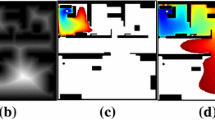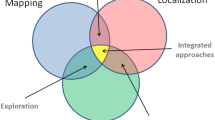Abstract
In order to safely navigate in a dynamic environment, a robot requires to know how the objects populating it will move in the future. Since this knowledge is seldom available, it is necessary to resort to motion prediction algorithms. Due to the difficulty of modeling the various factors that determine motion (e.g., internal state, perception), this is often done by applying machine-learning techniques to build a statistical model, using as input a collection of trajectories array through a sensor (e.g., camera, laser scanner), and then using that model to predict further motion.
This section describes the basic concepts involved in current motion learning and prediction approaches. After introducing the Bayes filter, it discusses Growing Hidden Markov Models, an approach which is able to perform lifelong learning, continuously updating its knowledge as more data are available. In experimental evaluation against two other state-of-the-art approaches, the presented approach consistently outperforms them regarding both prediction accuracy and model parsimony.
The section concludes with an overview of the current challenges and future research directions for motion modeling and learning algorithms.
Access this chapter
Tax calculation will be finalised at checkout
Purchases are for personal use only
Similar content being viewed by others
References
Bennewitz M, Burgard W, Cielniak G, Thrun S (2005) Learning motion patterns of people for compliant robot motion. Int J Robot Res 24(1):31–48
Brand M, Oliver N, Pentland A (1997) Coupled hidden markov models for complex action recognition. In: Proceedings of the 1997 conference on computer vision and pattern recognition, San Juan, pp 994–999
Dee H-M (2005) Explaining visible behaviour. PhD thesis, University of Leeds
Hoogs A, Perera AA (2008) Video activity recognition in the real world. In: Proceedings of the twenty-third AAAI conference on artificial intelligence, Chicago, pp 1551–1554
Hu W, **ao X, Fu Z, **e D, Tan T, Maybank S (2006) A system for learning statistical motion patterns. IEEE Trans Pattern Anal Mach Intell 28(9):1450–1464
Jockusch J, Ritter H (1999) An instantaneous topological map for correlated stimuli. In: Proceedings of the international joint conference on neural networks, vol 1, Washington DC, pp 529–534
Juang B-H, Levinson SE, Sondhi MM (1986) Maximum likelihood estimation for multi-variate mixture observations of markov chains. IEEE Trans Inf Theory 32(2):307–309
Liao L, Fox D, Kautz H (2004) Learning and inferring transportation routines. In: Proceedings of the national conference on artificial intelligence AAAI-04, Amsterdam
Magee D (2004) Tracking multiple vehicles using foreground, background and shape models. Image Vision Comput 22:143–155
Makris D, Ellis T (2002) Spatial and probabilistic modelling of pedestrian behavior. In: Proceedings of the British machine vision conference, Cardiff, pp 557–566
Mozos OM (2008) Semantic place labeling with mobile robots. PhD thesis, University of Freiburg, Freiburg
Neal RM, Hinton GE (1998) A new view of the em algorithm that justifies incremental, sparse and other variants. In: Jordan MI (ed) Learning in graphical models. Kluwer Academic, Dordrecht, pp 355–368
Oliver NM, Rosario B, Pentland AE (2000) A Bayesian computer vision system for modeling human interactions. IEEE Trans Pattern Anal Mach Intell 22(8):831–843
Rabiner LR (1990) A tutorial on hidden markov models and selected applications in speech recognition. Read Speech Recog 77:267–296
Reif J, Sharir M (1985) Motion planning in the presence of moving obstacles. In Symposium on the foundations of computer science, Portland, pp 144–154
Thrun S, Burgard W, Fox D (2005) Probabilistic robotics. MIT Press, Cambridge, MA
Vasquez D (2007) Incremental learning for motion prediction of pedestrians and vehicles. PhD thesis, Institut National Polytechnique de Grenoble, Grenoble. http://emotion.inrialpes.fr/bibemotion/2007/Vas07. Accessed 28 Sept 2011
Vasquez D, Fraichard T, Laugier C (2009) Growing hidden markov models: a tool for incremental learning and prediction of motion. Int J Robot Res 28(11–12):1486–1506
Walter M, Psarrow A, Gong S (1999) Learning prior and observation augmented density models for behaviour recognition. In: Proceedings of the British machine vision conference, Malvern, Worcestershire, pp 23–32
Author information
Authors and Affiliations
Corresponding author
Editor information
Editors and Affiliations
Rights and permissions
Copyright information
© 2012 Springer-Verlag London Ltd.
About this entry
Cite this entry
Vasquez, D., Laugier, C. (2012). Modeling and Learning Behaviors. In: Eskandarian, A. (eds) Handbook of Intelligent Vehicles. Springer, London. https://doi.org/10.1007/978-0-85729-085-4_51
Download citation
DOI: https://doi.org/10.1007/978-0-85729-085-4_51
Publisher Name: Springer, London
Print ISBN: 978-0-85729-084-7
Online ISBN: 978-0-85729-085-4
eBook Packages: EngineeringReference Module Computer Science and Engineering




